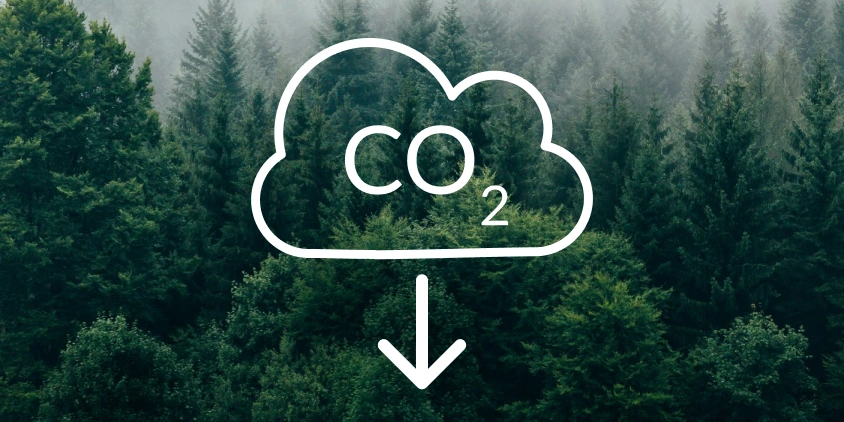
Carbon Sequestration Role And Environmental Impacts
As the rate of global warming continues to rise, businesses, communities, and policymakers are more interested in finding ways to stop it. Carbon sequestration is one such way. Through this process, a significant amount of greenhouse gas can be extracted from the atmosphere and safely stored elsewhere, leading to a positive impact on the environment. The carbon sequestration process occurs continuously in Earth’s ecosystems on its own, but humans can activate this process and use current technologies to artificially launch it. Carbon credits can incentivize wider adoption of carbon sequestration projects.
What Is Carbon Sequestration?
Carbon sequestration refers to removing carbon dioxide (CO2) from the Earth’s atmosphere and storing it in so-called pools. Since CO2 amplifies the greenhouse effect, this process is crucial for humanity’s fight against climate change. Sequestering, which occurs naturally on the largest scale, can also be intentionally promoted or triggered through a variety of natural and technological means. Thus, there are two forms of the process:
- natural form. All organic life, from water and land to trees and animals, serves as a natural CO2 sink. When living things naturally decompose, most of their carbon content goes into the earth, where it hardly contributes to climate change.
- artificial form. Numerous operations that are initiated by humans involve capturing CO2 emissions after production and subsequently burying or reusing them.
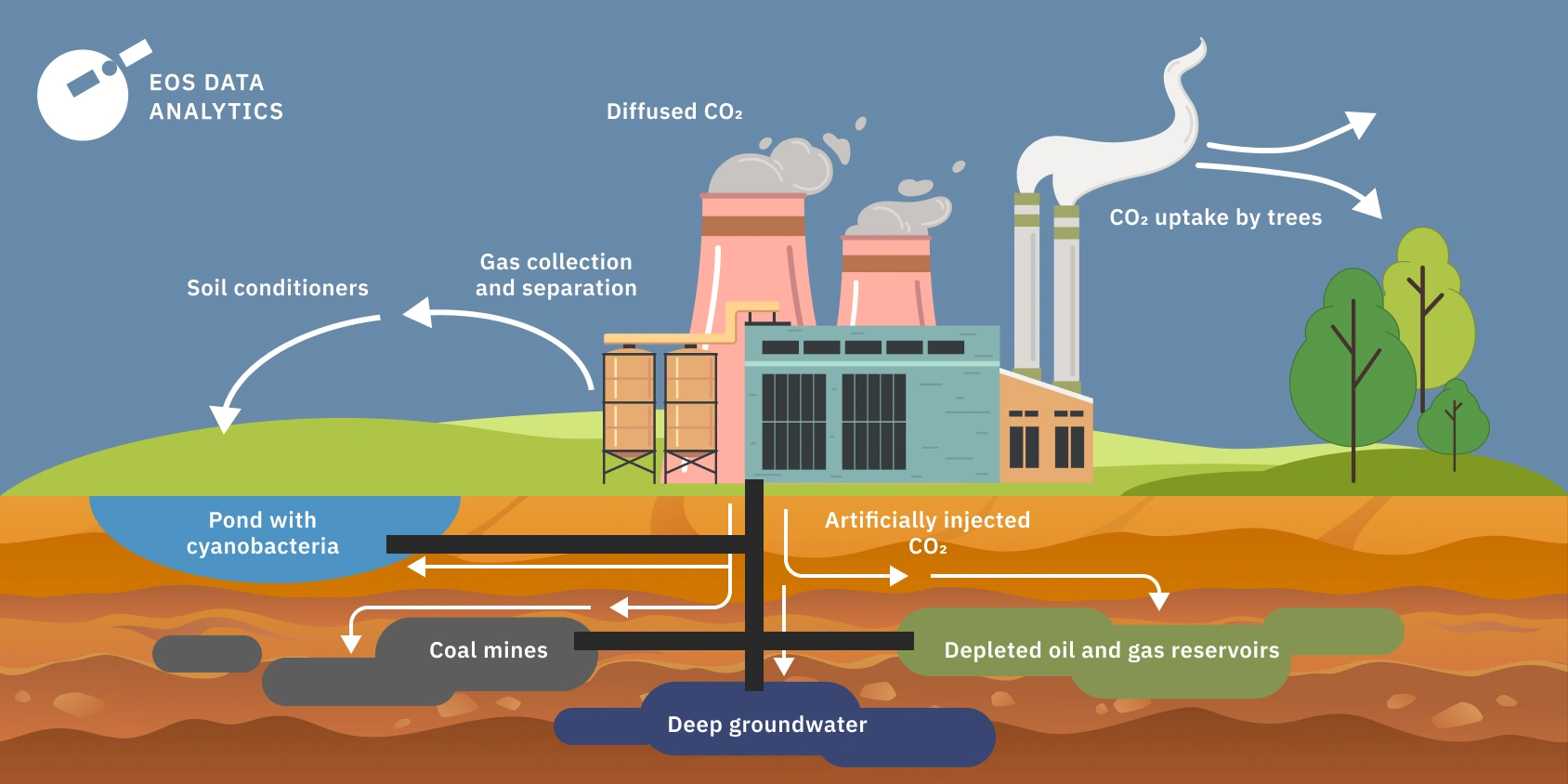
How Does Carbon Sequestration Work?
Natural sequestration of carbon keeps CO2 away from Earth’s atmosphere through two main natural mechanisms:
- Plant photosynthesis. Plant life absorbs atmospheric CO2, stores it in biomass, and releases oxygen in exchange.
- Decomposition of organic matter. As time passes, the decay of organic matter releases carbon into the soil.
Human activities, such as reforestation, reduced tillage, crop residue management, and CO2 capture, help facilitate these processes.
Why Is Carbon Sequestration Important?
Over the past 250 years, human activity has caused a significant increase of around 35% in CO2 concentration in the atmosphere, resulting in noticeable global warming . By blocking CO2 entry into the atmosphere, carbon sequestration has shown enormous potential for mitigating climate change. Since certain industries, like aviation and heavy industry, are notoriously difficult to decarbonize, sequestering their emissions is essential for offsetting their footprint and achieving net-zero emissions.
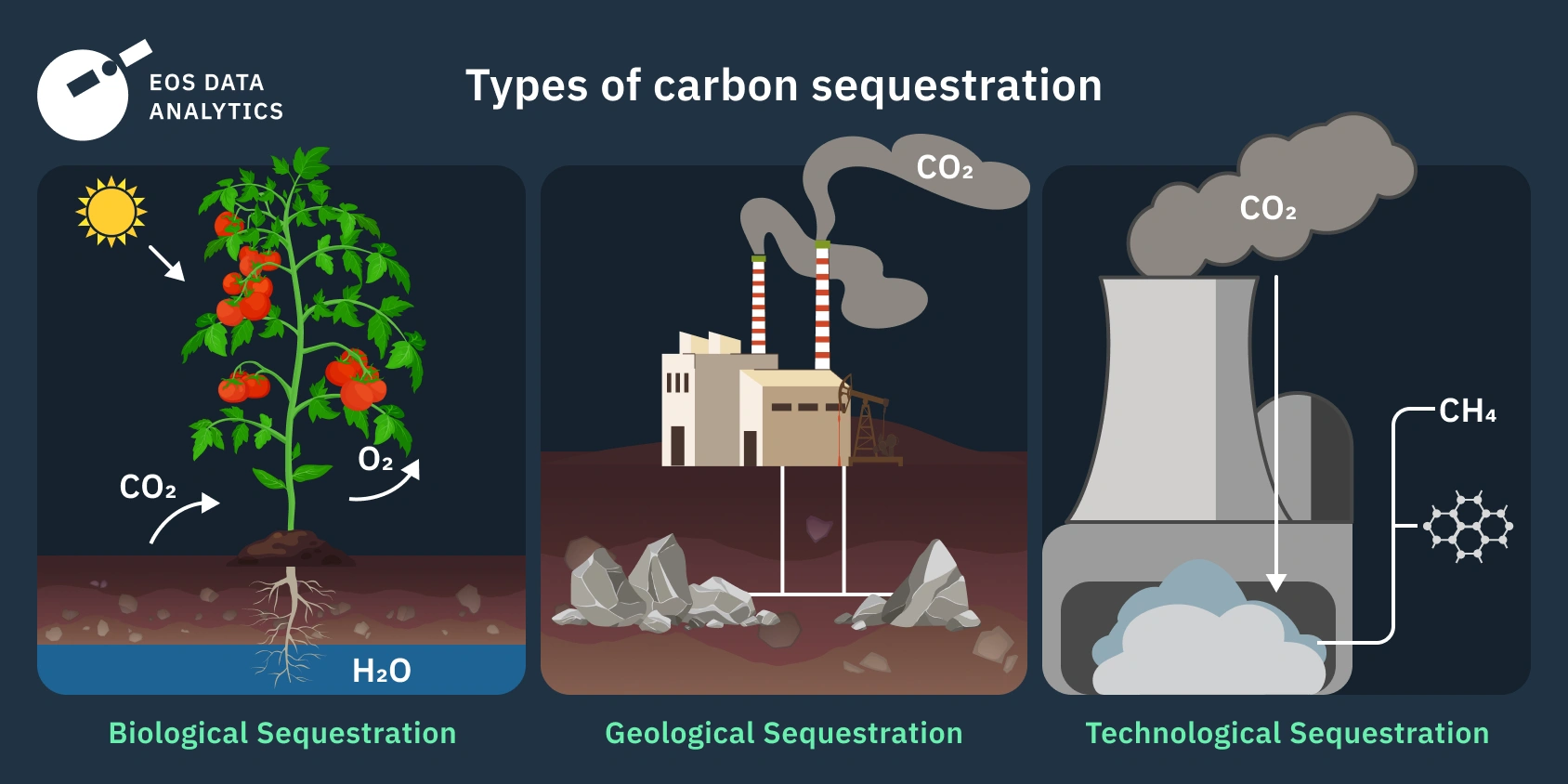
What Are The Types And Methods Of Carbon Sequestration?
There are three main types of CO2 sequestration: biological, which occurs in ecosystems, geological, taking place in rock formations, and technological, driven by specific human activities.
Biological Carbon Sequestration
Biological sequestration refers to the storage of CO2 in natural ecosystems such as grassland and forest plants, soils, and oceans. What are the potential ways to promote biological sequestration? Let’s examine this in depth.
Forest Carbon Sequestration
Forests and woodlands are among the most effective natural terrestrial sequestration systems because of the massive amounts of CO2 they capture through photosynthesis. In fact, they have captured nearly 30% of the CO2 emissions caused by humans over the last several decades . However, deforestation and forest fragmentation pose serious threats to the sequestration process.
Instead, there are two directions for human intervention to improve forest tree carbon sequestration:
- planting trees both in previously forested (reforestation) and non-forested (afforestation) areas;
- sustainable forest management, encompassing practices such as selective logging, timber thinning, and prescribed burning.
Grassland Carbon Sequestration
Despite forests’ reputation as CO2 absorbers, trees are in danger of actually contributing to climate change as a result of droughts and wildfires. Grasslands are more resilient to these calamities because, unlike trees, grasses store most of their carbon content underground. Even after a fire, grasses retain their stores in the soil and deep roots.
The following approaches can increase grassland areas and contribute to sequestration:
- revitalizing deteriorated lands to increase their storage capacity;
- nurturing agroforestry systems, which serve as significant CO2 absorbers.
Soil Sequestration
As organic matter decomposes, it leaves behind soil organic carbon (SOC), a storage form of CO2 in the soil. In most cases, SOC has a CO2 storage capacity of several decades. Soil organic carbon sequestration is one of the most economical strategies for mitigating the impacts of climate change. Here are some methods to promote carbon sequestration in agricultural soils:
- conservation tillage, which aims to minimize soil disturbance to preserve SOC levels;
- growing cover crops to add biomass to the soil and reduce erosion;
- crop rotations, particularly those involving large-biomass crops;
- crop residue management that prevents residue burning and instead helps enrich the soil with organic matter and protect it from erosion in the off-season.
Ocean Fertilization
Ocean fertilization, which involves adding limiting nutrients like iron to ocean waters, can enhance CO2 fixation across a large portion of the oceans . However, this technique is not without controversy. If the amount of blue carbon (stored in the ocean’s top layers) is excessive, the aquatic ecosystem is at risk of acidification and related side effects. International legal regulations should be implemented to ensure that ocean carbon sequestration is done safely.
Geological Carbon Sequestration
Geological sequestering involves artificially injecting CO2 (usually from industrial sources) into underground rock bodies. Examples of these sinks are as follows:
- Deep saline aquifers. Stable carbonate minerals eventually form in deep, saltwater-soaked formations.
- Exhausted oil and gas reservoirs. Storing CO2 there contributes to oil recovery.
- Unmineable coal seams. CO2 adsorbed on the coal surface allows for the collection of displaced methane for further recovery and use as an energy source.
- Basalt formations. In basalt formations, CO2 reacts with minerals, allowing stable carbonate minerals to form quickly.
Technological Carbon Sequestration
Scientists are always on the lookout for fresh methods to extract CO2 from the atmosphere and store or, better yet, reuse it through cutting-edge technologies, such as:
- CO2 capture and storage (CCS). This approach, closely related to geological sequestration, involves capturing emissions from power stations or industrial plants, compressing and transporting the gas through pipe networks, and injecting it into geological formations for storage.
- Graphene production. Capturing CO2 emissions from the construction industry and using accelerated carbonization to produce graphene, a carbon-based technological material.
- Direct air capture (DAC). The technology relies on specialized advanced plants, and although it is effective, it remains prohibitively expensive and energy-intensive for widespread adoption.
- Engineered molecules. This innovative approach allows for the simultaneous reduction of atmospheric emissions and the production of raw materials through the conversion of CO2 molecules into other chemical compounds.

What Are The Benefits And Challenges Of Carbon Sequestration?
There don’t seem to be any disadvantages to carbon sequestration. From an environmental perspective, it is largely accurate. At the same time, it is crucial to prevent any deceptive utilization of this process.
Benefits Of Carbon Sequestration
There are numerous environmental and economic benefits of carbon sequestration when it is well planned and executed. Namely, they are:
- Climate change mitigation. Natural sequestering of emissions is one of the most practical strategies for addressing climate change, as it effectively and sustainably lowers atmospheric concentrations of CO2, a potent greenhouse gas.
- Improved soil fertility and increased farming productivity. Sequestering SOC attracts investment in regenerative and climate smart agriculture. As a result, soils become healthier, crop yields increase, and agricultural resilience to climate change grows.
- Better public health. Headache, vertigo, trouble breathing, and a racing heart are just a few of the symptoms reported after extended exposure to high levels of CO2 . All of these impacts can be considerably reduced, and people’s health improved in the long run through properly implemented carbon sequestration.
- Economic incentives. Businesses and organizations involved in sequestration initiatives can cover the initial investment and generate sustainable income streams by selling carbon credits (CCs).
Challenges Of Carbon Sequestration
Notwithstanding the many benefits of sequestering emissions, it’s crucial to look at the flip side of it:
- High initial costs. Massive investments in research, infrastructure, and equipment are necessary for the sequestering initiatives to achieve their goals. However, as previously stated, carbon dioxide sequestration credits can make up for these expenses.
- Greenwashing. Some polluting sectors may use sequestering CO2 as an excuse to avoid seeking out direct ways to cut their emissions, even if those solutions are possible. Fortunately, regulations are in place to deter businesses from abusing CCs.
Overall, a transparent and well-thought-out approach to sequestering emissions addresses the issues mentioned.
How Can Businesses Implement CO2 Sequestration Strategies?
Monitoring and verification are essential components of each and every emission-sequestering project. The following steps will help ensure that the chosen methods are safe and effective:
- baseline measurements to determine initial conditions before carrying out any sequestration activity;
- continuous monitoring of CO2 stocks using ground-based examinations and remote sensing technologies;
- claim verification using established protocols and other standardized techniques.
By combining soil testing and remote sensing data, EOSDA provides carbon project developers with a novel solution for SOC modeling. To establish a starting point for future comparisons, our model shows the amount of organic carbon in the soil at a certain location. Afterward, it allows you to comprehend the transformation that has taken place as a result of carbon sequestration efforts.
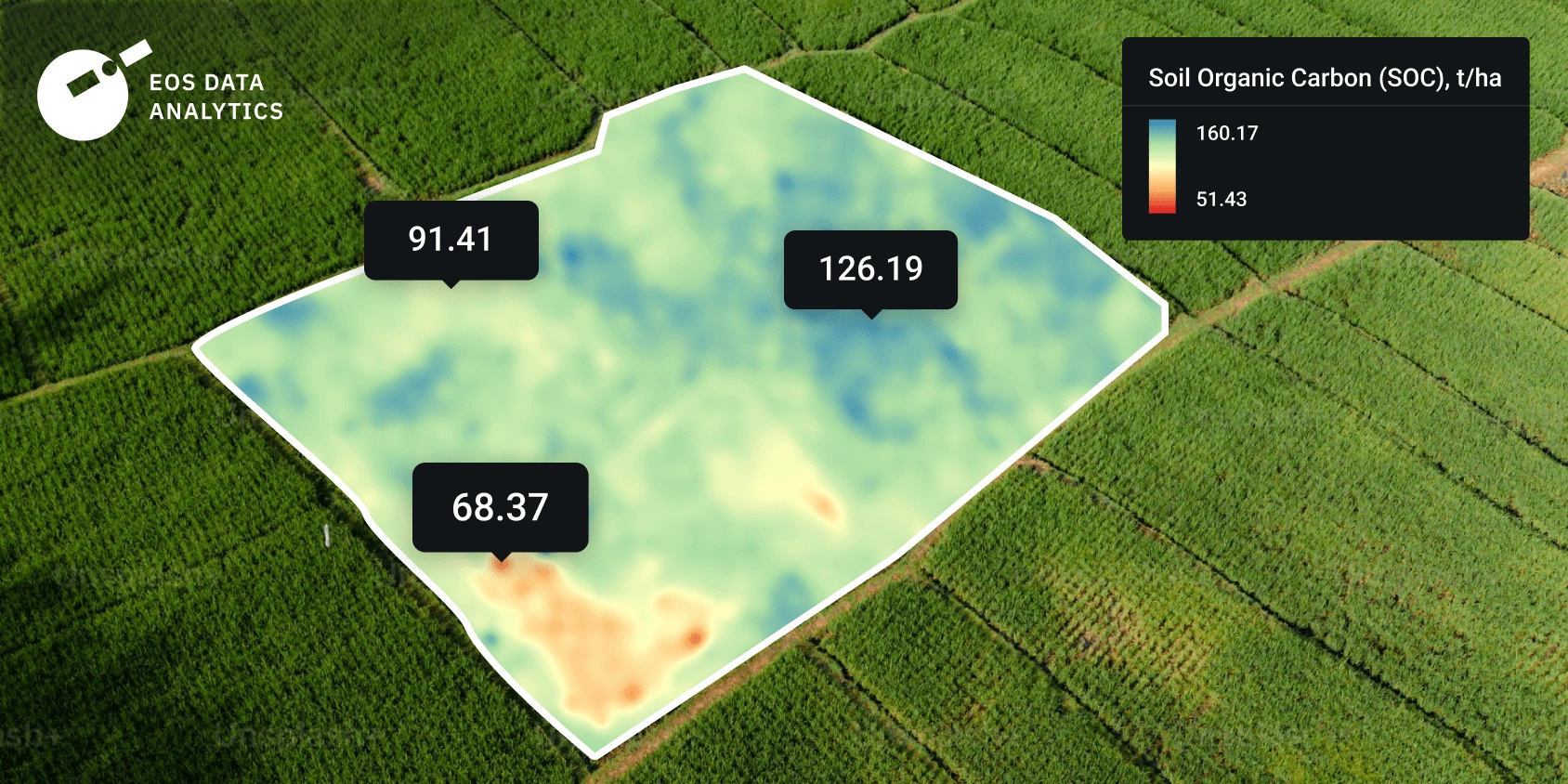
Our solution can benefit a wide range of businesses and organizations, particularly sustainability enthusiasts and project developers in large-scale farming, agroforestry, and grassland ownership. EOSDA’s SOC technology offers several prominent capabilities, such as:
- accurate modeling and mapping enable more cost-effective soil sample collection;
- using the model as a foundation to generate CO2 credits;
- forecasting SOC levels in response to different field activity scenarios.
To guarantee the most accurate representation of SOC distribution on the map, we carefully analyze and incorporate numerous factors, such as climate, weather, and elevation, into the model. Get in touch with our sales team for more information on how to apply our SOC modeling solution to your carbon sequestration projects.
Trends Shaping The Future Of Carbon Sequestration
In the face of alarming predictions about extreme weather patterns and increasing global temperatures, experts and sustainability enthusiasts are actively exploring solutions to mitigate those escalating risks. While there isn’t yet a silver bullet, the rapid advancements in carbon capture and sequestration technology over the past decades bode well for future efforts to combat climate change. Beyond improving CO2 removal methods, researchers are now looking into its potential as a resource.
Promoting sustainable agriculture, reforestation, and afforestation is the most fundamental and cost-effective strategy for scaling up CO2 sequestering initiatives. Moreover, these strategies come with significant long-term benefits to communities and the environment.
Sequestering emissions cannot substitute for efficient energy management or expanding the use of carbon-free technologies. It is nonetheless a crucial complement, as it helps to alleviate the challenges of tackling climate change.
About the author:
Lidiia Lelechenko holds a Master Degree in Viticulture, Winemaking & Marketing obtained in ESA (École supérieure d'agricultures d'Angers). She has over 6 years of experience in various roles related to SaaS solutions sales and research activities in sensory analysis. Currently, Lidiia is responsible for strengthening EOSDA presence and recognition on European markets as an Account Executive.
Recent articles
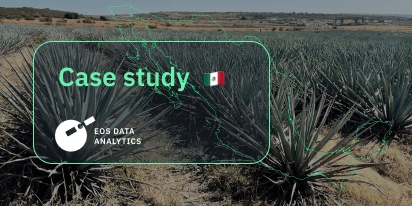
Digital Tools Improve Soil Health And Yields In Mexico
EOSDA and ITTA supported a Guanajuato farm with contour-line planning, monitoring tools, and practical guidance to reduce soil erosion and improve yields in the long run.

Analyze 2025 & Plan Your Best Year Yet: LandViewer Christmas Offer
It’s the most wonderful time of the year! The Christmas holidays are here, and so is your chance to analyze 2025 and plan a prosperous 2026 with more affordable Pro plans in LandViewer.

EOSDA Models Climate Change Impact On Sugarcane Yields
EOSDA modeled future temperature, rainfall, and other climate impacts on Veracruz sugarcane. The results help growers plan long-term adaptation strategies, including timing, varieties, and irrigation.